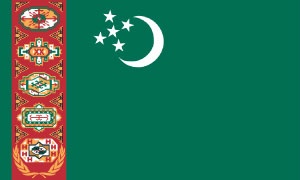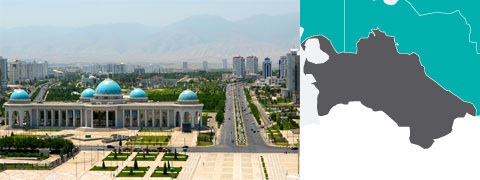Country assessments
Turkmenistan
- Details
- Country assessments
2013 sector transition indicators
Source: EBRD.
Note: Water – Water and wastewater; IAOFS – Insurance and other financial services; PE – Private equity.
Highlights
- Strong growth continued. Output grew by 11.1 per cent in 2012, supported by increased production of hydrocarbons, diversification of gas export routes and related infrastructure spending.
- A new privatisation programme was approved. The programme covers the period 2013-16, and in the first instance targets medium-sized enterprises across various sectors.
- Turkmenistan expressed interest in joining the World Trade Organization (WTO). A working group was created to look into accession issues.
Key priorities for 2014
- Bank lending practices need to be further commercialised. A move towards a higher share of credit, based on purely commercial principles, will help the move towards a more efficient allocation of capital resources throughout the economy.
- Further liberalisation of the external trade regime would support private sector development and export diversification. Following the adoption of the new law on foreign exchange regulations in 2011, flexibility could be further increased in the area of prepayments for imports and deferred payments for exports.
- The role of the private sector should be increased, and competition should be strengthened, in various key sectors of the economy. Stronger competition in sectors such as insurance and telecommunications would contribute to improving the availability of key services and infrastructure supporting private sector development. Transparency, including on extra-budgetary fiscal activities, needs to be further improved.
Macroeconomic performance
The economy continued to record fast GDP growth. Output expanded by 11.1 per cent in 2012, and by 9.4 per cent year-on-year in the first half of 2013. Growth was driven by the continued expansion of gas production and exports, owing to alternative gas export routes to China and Iran, in addition to traditional export markets via Russia. The fiscal position remains strong on the back of growing revenues from the sales of hydrocarbons. At the same time, the current account is estimated to have been in balance in 2012 – compared with a surplus of around 2 per cent of GDP in 2011 – due, in part, to higher levels of imports of capital goods needed to complete large gas development and infrastructure projects. The 2012 current account also reflects growing consumption in an economy in which output is strongly concentrated in the natural resources sector.
The exchange rate peg against the US dollar continues to anchor monetary policy. Inflation is estimated to have remained at a relatively modest level of around 6 per cent in 2012. Credit growth remained strong, at around 30 per cent year-on-year in the first half of 2013. While most bank lending continues to be channelled to state-owned enterprises, credit to the private sector has been growing rapidly, at rates of up to 50 per cent per annum, albeit from a fairly low base. Credit growth to the private sector was supported, in part, by special lending programmes for small and medium-sized enterprises and agriculture at subsidised interest rates.
GDP growth is expected to remain strong. In the medium term, GDP will continue to be driven by rising volumes of gas production and further diversification of export routes to Europe – possibly via Turkey. The economy is expected to continue to grow at a double digit rate in 2013. However, heavy state regulation and intervention constrain development of non-resource sectors of the economy, leading to increased risks to the medium-term economic outlook.
Major structural reform developments
The authorities have reiterated their commitment to privatisation, although progress in this area has so far been very limited. In November 2012 the president approved a privatisation programme covering the period 2013-16, accompanied by a list of mostly medium-sized enterprises that were available for privatisation. Foreign, as well as local, investors have been invited to participate in auctions for these enterprises. Energy sector assets are not currently on the list. The full modalities of the programme remain to be clarified. While progress in the privatisation programme has been limited thus far, the authorities have reiterated their commitment to increasing the share of the private sector in the economy to 70 per cent of non-hydrocarbon GDP by 2020. State-owned banks may also be considered for privatisation in the future, under the programme for banking sector development. Further, a new law that came into force in July 2013 provides for the privatisation of municipal accommodation free of charge to tenants, where tenants have resided in that accommodation for 10 years or more. Private investment has also returned to the telecommunications sector. Mobile TeleSystems OJSC (MTS) – a Russian mobile telecoms operator – which had its licence suspended in December 2010, resumed operations in late August 2012.
In January 2013 the authorities expressed interest in WTO accession. A working group on this issue has been created. A conference held in Ashgabad, in March 2013, covered the basic principles of WTO membership and the application process. Once the country’s application is formally initiated, accession is likely to take several years to complete.
Efforts have been made to improve the regulatory framework in the non-bank financial sector. A new insurance law was adopted in late 2012, coupled with a government programme to develop private insurance companies (currently there is only one state-owned insurance company). The authorities have also adopted a new state pension insurance law, and a state pension fund has been established. An action plan for securities market development for 2012-16 was adopted in November 2011, and actions under this plan are ongoing.
Work advanced on a number of important cross-border infrastructure projects. In May 2013 the presidents of Kazakhstan and Turkmenistan officially unveiled a new railway link connecting Western Kazakhstan with Northern Turkmenistan, with additional onward connections to Iran currently under construction. In addition, the presidents of Afghanistan, Tajikistan and Turkmenistan signed a preliminary memorandum of understanding on the construction of a 350 km railway linking Tajikistan with Turkmenistan, via Afghanistan (and thus bypassing Uzbekistan). The estimated cost of the link is US$ 2 billion. Both projects have strong potential to boost regional trade among landlocked countries in Central Asia, and between countries in the region and the rest of the world.
Turkmenistan continued actively seeking diversification of export routes for natural gas. The need for new export routes reflects the country’s plans to triple gas production volumes over the next two decades. Production at the Galkynysh natural gas deposit – the second largest natural gas deposit in the world – commenced in the summer of 2013. Against this backdrop, in May 2013 Turkmenistan and Turkey agreed on a framework to bring Turkmen gas to Europe via Turkey, by connecting Turkmen gas supplies to the Trans-Anatolian Pipeline (TANAP). Turkmenistan already exports gas to China, Iran and Russia.













